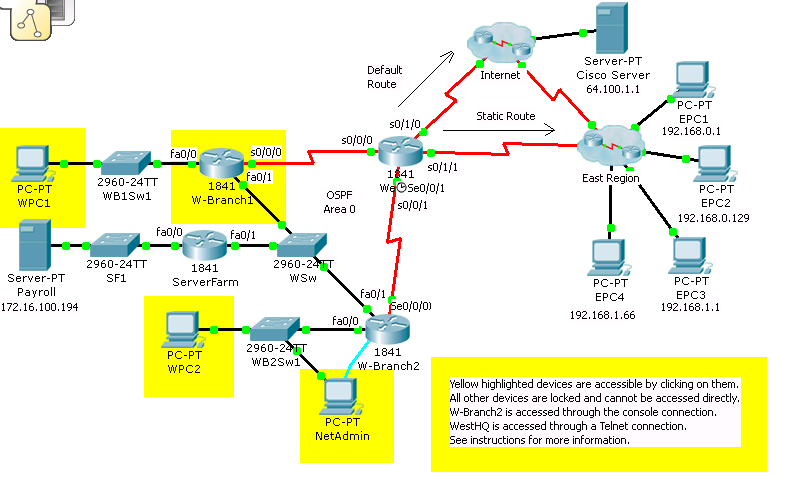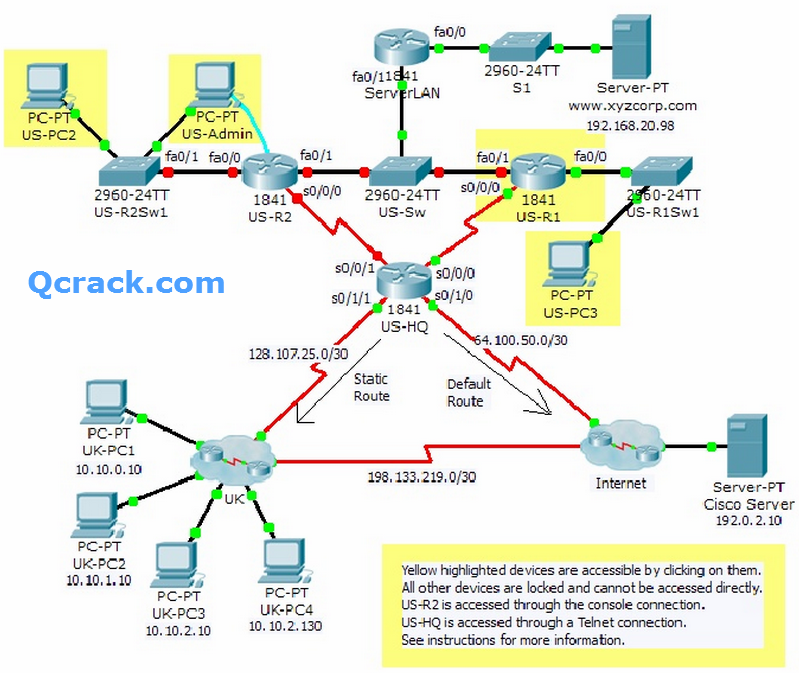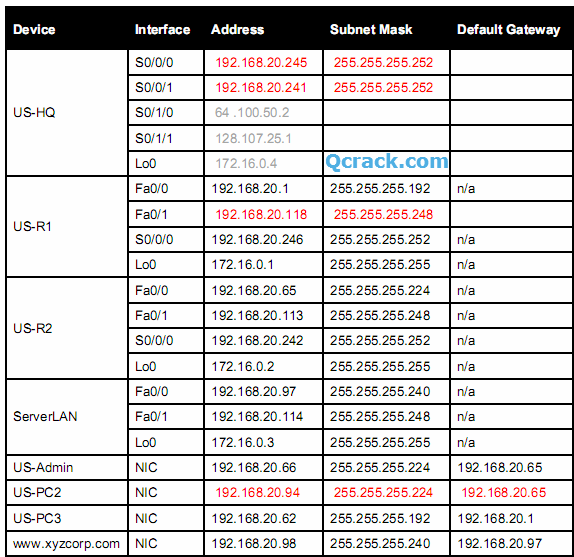ERouting OSPF PT Practice SBA

A few things to keep in mind while completing this activity:
1. Do not use the browser Back button or close or reload any Exam windows during the exam.
2. Do not close Packet Tracer when you are done. It will close automatically.
3. Click the Submit Assessment button to submit your work.
Introduction
In this practice Packet Tracer Skills Exam, you will:
- finish the configuration of a partially configured network
- establish connectivity to the East Region and the Internet through the use of static and dynamic routing
Addressing Table
| Device | Interface | Address | Subnet Mask | Default Gateway |
|---|---|---|---|---|
| WestHQ | S0/0/0 | 172.16.100.245 | 255.255.255.252 | |
| S0/0/1 | 172.16.100.241 | 255.255.255.252 | ||
| S0/1/0 | ||||
| S0/1/1 | ||||
| Lo0 | ||||
| W-Branch1 | Fa0/0 | 172.16.100.1 | 255.255.255.128 | n/a |
| Fa0/1 | 172.16.100.238 | 255.255.255.240 | ||
| S0/0/0 | 172.16.100.246 | 255.255.255.252 | n/a | |
| Lo0 | 10.0.0.1 | 255.255.255.255 | n/a | |
| W-Branch2 | Fa0/0 | 172.16.100.129 | 255.255.255.192 | n/a |
| Fa0/1 | 172.16.100.225 | 255.255.255.240 | n/a | |
| S0/0/0 | 172.16.100.242 | 255.255.255.252 | n/a | |
| Lo0 | 10.0.0.2 | 255.255.255.255 | n/a | |
| ServerFarm | Fa0/0 | 172.16.100.193 | 255.255.255.224 | n/a |
| Fa0/1 | 172.16.100.226 | 255.255.255.240 | n/a | |
| Lo0 | 10.0.0.3 | 255.255.255.255 | n/a | |
| WPC1 | NIC | 172.16.100.126 | 255.255.255.128 | 172.16.100.1 |
| WPC2 | NIC | 172.16.100.190 | 255.255.255.192 | 172.16.100.129 |
| NetAdmin | NIC | 172.16.100.130 | 255.255.255.192 | 172.16.100.129 |
| Payroll | NIC | 172.16.100.194 | 255.255.255.224 | 172.16.100.193 |
Note: The password for user EXEC mode is cisco. The password for privileged EXEC mode is class.
Step 1: Connect the Devices.
- Connect WestHQ S0/0/1 to W-Branch2 S0/0/0. WestHQ is the DCE side of the link and is setting the clock rate.
- Connect W-Branch2 to an available interface on WSw.
Step 2: Configure the Device Basics.
Note: Initially, you can only access router W-Branch2 through the console connection on NetAdmin.
a. Configure the following on W-Branch2:
- The router name is WB2.
- The privileged EXEC mode uses the following encrypted password: class.
- Enable Telnet and console line login using the following password: cisco.
- Configure the banner message-of-the-day as Authorized access only!
b. Configure and verify interface addressing on W-Branch2.
- Using the Addressing Table, configure and activate all the necessary interfaces on W-Branch2.
- Verify connectivity.
c. Configure the correct IP addresses on WPC2 and W-Branch1.
- Configure WPC2 with the last IP address in the subnet.
- Configure the Fa0/1 interface on W-Branch1 with the last IP address in the subnet.
d. Verify connectivity.
Step 3: Discover the Network.
- Explore the network to determine the IP addressing of the serial interfaces that WestHQ shares with W-Branch1 and W-Branch2.
- Remotely access WestHQ.
Step 4: Configure Static and Default Routing.
a. Configure connectivity to the East Region.
• Using the next hop address 192.0.0.2, configure one summary static route on WestHQ for the entire East Region. The summary should include addresses reserved for future expansion. The East Region subnets are listed in the following table: 192.168.0.0/23
WHQ(config)#ip route 192.168.0.0 255.255.254.0 192.0.0.2
| East Region Subnets |
|---|
| 192.168.1.248/30 |
| 192.168.1.252/30 |
| 192.168.1.244/30 |
| 192.168.0.0/25 |
| 192.168.0.128/25 |
| 192.168.1.0/26 |
| 192.168.1.64/26 |
| 192.168.1.128/26 192.168.1.192/27 192.168.1.224/28 192.168.1.240/30 |
• Configure a default route on WestHQ to send to the Internet all other traffic for destinations that are not found in the WestHQ routing table. Use the outbound interface argument. WHQ(config)#ip route 0.0.0.0 0.0.0.0 s0/1/0
b. Verify static and default routing.
Step 5: Configure OSPF Routing.
a. Configure OSPF on WestHQ, W-Branch1, and W-Branch2.
- Use OSPF process ID 1 and area 0.
- Advertise each subnet individually with its corresponding wildcard mask. On WestHQ, do not advertise the subnet to the Internet or the subnet to East Region.
- Disable OSPF updates out interfaces where there are no OSPF neighbors available.
- Configure WestHQ to send the default route to W-Branch1 and W-Branch2 in OSPF updates.
WestHQ
WHQ(conf t)#router ospf 1 WHQ(config-router)#network 172.16.100.244 0.0.0.3 area 0 WHQ(config-router)#network 172.16.100.240 0.0.0.3 area 0 WHQ(config-router)#default-information originate ; WHQ sends the default route to ; WB1 & WB2 WHQ(config-router)#passive-interface s0/1/0 ; disable OSPF updates WHQ(config-router)#passive-interface s0/1/1 ; disable OSPF updates
WBranch1
WB1(conf t)#router ospf 1 WB1(config-router)#network 172.16.100.0 0.0.0.127 area 0 WB1(config-router)#network 172.16.100.224 0.0.0.15 area 0 WB1(config-router)#network 172.16.100.244 0.0.0.3 area 0
WBranch2
WB2(conf t)#router ospf 1 WB2(config-router)#network 172.16.100.128 0.0.0.63 area 0 WB2(config-router)#network 172.16.100.224 0.0.0.15 area 0 WB2(config-router)#network 172.16.100.240 0.0.0.3 area 0
b. Modify the default OSPF operation.
• Configure W-Branch1 to always be the DR by using a priority of 100.
AO amle interface fa0/1 sy s0/0/0 WB1(config-if)#ip ospf priority 100
• Configure W-Branch2 to always be the BDR by using a priority of 50.
AO amle interface fa0/1 sy s0/0/0 WB2(config-if)#ip ospf priority 50
• Change the hello interval to 20 seconds on W-Branch1 and W-Branch2 for the LAN that these two routers share with ServerFarm.
Ao amle WB1_f0/1 sy WB2_f0/1 WB1(config-if)#ip ospf hello-interval 20 WB2(config-if)#ip ospf hello-interval 20
• Verify OSPF neighbor status.
Router#sh ip ospf neighbor ,etc....
c. Verify that OSPF is fully operational.
• Verify that the routing tables on W-Branch1, W-Branch2, and WestHQ contain all the expected routes.
Router#sh ip route ,etc....
Step 6: Verify Full Connectivity.
Although these are not scored, the following connectivity tests should be successful.
- To test the static route to East Region, successfully ping between WestHQ and EPC1.
- To test the OSPF neighbor establishment with ServerFarm, successfully ping between WPC1 and Payroll.
- To test end-to-end connectivity between the East and West Regions, successfully ping between WPC2 and EPC3.
- To test the default route, successfully ping the Cisco Server from NetAdmin.
ERouting OSPF PT Practice SBA :
A few things to keep in mind while completing this activity:
1. Do not use the browser Back button or close or reload any exam windows during the
exam.
2. Do not close Packet Tracer when you are done. It will close automatically.
3. Click the Submit Assessment button to submit your work.
Introduction
In this practice Packet Tracer Skills Exam, you will:
- finish the configuration of a partially configured network
- establish connectivity to the UK and the Internet through the use of static and dynamic routing
Note: The password for user EXEC mode is cisco. The password for privileged EXEC mode is class.
Step 1: Finish the IP Addressing.
Note: Initially, you can only access router US-R2 through the console connection on US-
Admin.
a. Configure and verify interface addressing on US-R2.
Configure and activate all interfaces for US-R2 that are listed in the
addressing table.
b. Configure the correct IP addresses on US-PC2 and US-R1.
Configure US-PC2 with the last IP address in the subnet.
Configure the Fa0/1 interface on US-R1 with the last IP address in the
subnet.
c. Verify connectivity.
Step 2: Discover the Network.
Explore the network to determine the IP addressing of the serial interfaces that US-
HQ shares with US-R1 and US-R2.
Remotely access US-HQ. US-R1# telnet 192.168.20.245
Step 3: Configure Static and Default Routing.
a. Configure connectivity to the UK.
- Using the next hop address 128.107.25.2, configure one summary static route on US-HQ to include only the subnets used and reserved for the UK. The UK subnets are listed in the following table:
HQ(config)# ip route 10.10.0.0 255.255.255.252 128.107.25.2

- Configure a default route on US-HQ to send to the Internet all other traffic for destinations that are not found in the US-HQ routing table. Use the outbound interface argument.
HQ(config)# ip route 0.0.0.0 0.0.0.0 S0/1/0
b. Verify static and default routing.
Step 4: Configure OSPF Routing.
a. Configure OSPF on US-HQ, US-R1, and US-R2.
Use OSPF process ID 3 and area 0.
Advertise each subnet individually with its corresponding wildcard mask. On US-HQ, do not advertise the subnet to the Internet or the subnet to UK.
HQ(config)# router ospf 3
HQ(config-router)# network 192.168.20.244 0.0.0.3 area 0
HQ(config-router)# network 192.168.20.240 0.0.0.3 area 0
US-R1 (config)# router ospf 3
US-R1 (config-router)# network 192.168.20.0 0.0.0.63 area 0
US-R1 (config-router)# network 192.168.20.112 0.0.0.7 area 0
US-R1 (config-router)# network 192.168.20.244 0.0.0.3 area 0
US-R2 (config)# router ospf 3
US-R2 (config-router)# network 192.168.20.64 0.0.0.31 area 0
US-R2 (config-router)# network 192.168.20.112 0.0.0.7 area 0
US-R2 (config-router)# network 192.168.20.240 0.0.0.3 area 0
Disable OSPF updates out interfaces where there are no OSPF
neighbors available.
HQ(config-router)# passive-interface s0/1/0
HQ(config-router)# passive-interface s0/1/1
US-R1 (config-router)# passive-interface fa0/0
US-R2 (config-router)# passive-interface fa0/0
Configure US-HQ to send the default route to US-R1 and US-R2 in
OSPF updates.
HQ(config-router)# default-information originate
b. Modify the default OSPF operation.
Configure US-R1 to always be the DR by using a priority of 150.
Pour Fa0/1 , S0/0
US-R1 (config-if)# ip ospf priority 150
Configure US-R2 to always be the BDR by using a priority of 75.
Pour Fa0/1 , S0/0
US-R2 (config-if)# ip ospf priority 75
Change the hello interval to 30 seconds on US-R1 and US-R2 for the
LAN that these two routers share with ServerLAN.
US-R1 (config-if)# ip ospf hello-interval 30
US-R2 (config-if)# ip ospf hello-interval 30
Verify OSPF neighbor status.
US-R1# show ip ospf neighbor
c. Verify that OSPF is fully operational.
Verify that the routing tables on US-R1, US-R2, and US-HQ contain all
the expected routes. It may be necessary to shutdown and then
reactivate interfaces to force OSPF to converge.
US-R1# show ip route
Step 5: Verify Full Connectivity.
Although these are not scored, the following connectivity tests should be successful.
To test the static route to UK, successfully ping between US-HQ and UK-PC1.
To test the OSPF neighbor establishment with ServerLAN, successfully ping between
US-Admin and www.xyzcorp.com.
To test end-to-end connectivity between the US and UK, successfully ping between
US-PC2 and UK-PC3.
To test the default route, successfully ping the Cisco Server from US-Admin.
==============================
SUMMARY:
US-PC2
------
192.168.20.94
255.255.255.224
192.168.20.65
US-R2
=====
cisco enable class config ter
interface fa0/0
ip add 192.168.20.65 255.255.255.224 no shutdown
exit
inteface fa0/1
ip add 192.168.20.113 255.255.255.248 no shutdown
exit
interface s0/0/0
ip add 192.168.20.242 255.255.255.252 no shutdown
exit
inteface Lo0
ip add 172.16.0.2 255.255.255.255 no shutdown
exit
router ospf 3
network 192.168.20.64 0.0.0.31 area 0 network 192.168.20.112 0.0.0.7 area 0 network 192.168.20.240 0.0.0.3 area 0 passive-interface fastEternet 0/0
interface s0/0/0
ip ospf priority 75 exit
interface f0/1
ip ospf priority 75 exit
inteface f0/1
ip ospf hello-interval 30 end
show ip route
=================
Telnet
telnet 192.168.20.240
=====================
US-HQ
--------
cisco enable class
show ip route
conf term
ip route 10.10.0.0 255.255.252.0 128.107.25.2 ip route 0.0.0.0 0.0.0.0 s0/1/0
router ospf 3
network 192.168.20.244 0.0.0.3 area 0 network 192.168.20.240 0.0.0.3 area 0 default-information originate passive-interface s0/1/0
passive interface s0/1/1
exit
show ip route
=================
Open US-R1
=====================
US-R1
--------
cisco enable class
config term
interface fa0/1
ip add 192.168.20.118 255.255.255.248 no shutdown
exit
router ospf 3
network 192.168.20.0 0.0.0.63 area 0 network 192.168.20.112 0.0.0.7 area 0 network 192.168.20.244 0.0.0.3 area 0
passive-interface fa0/0 exit
do wr
interface f0/1
ip ospf priority 150
ip ospf hello-interval 30
exit
interface s0/0/0
ip ospf priority 150 exit
show ip route
exit
*************************
US-HQ
------
Serial0/0/0 192.168.20.245
Serial0/0/1 192.168.20.241
Serial0/1/0 64.100.50.2
Serial0/1/1 128.107.25.1
Download Full PDF file:
Have Fun!!



i cant access the westHQ please help!
thanks
thanx